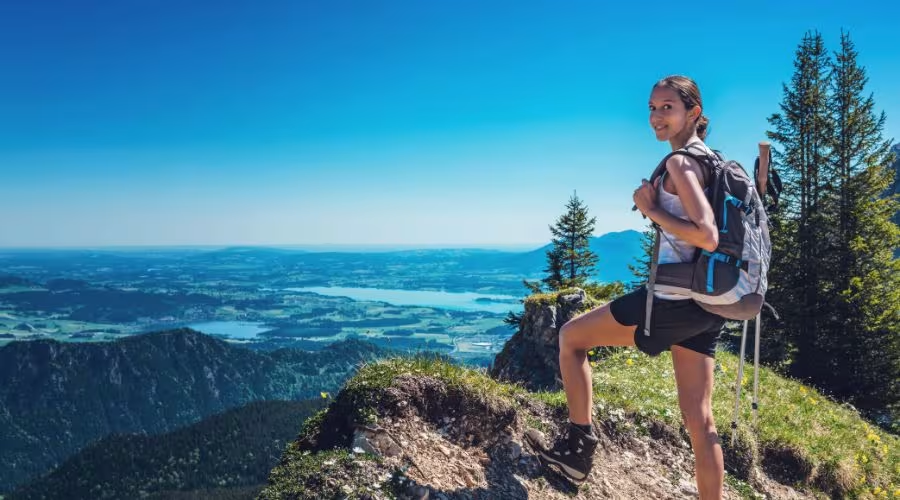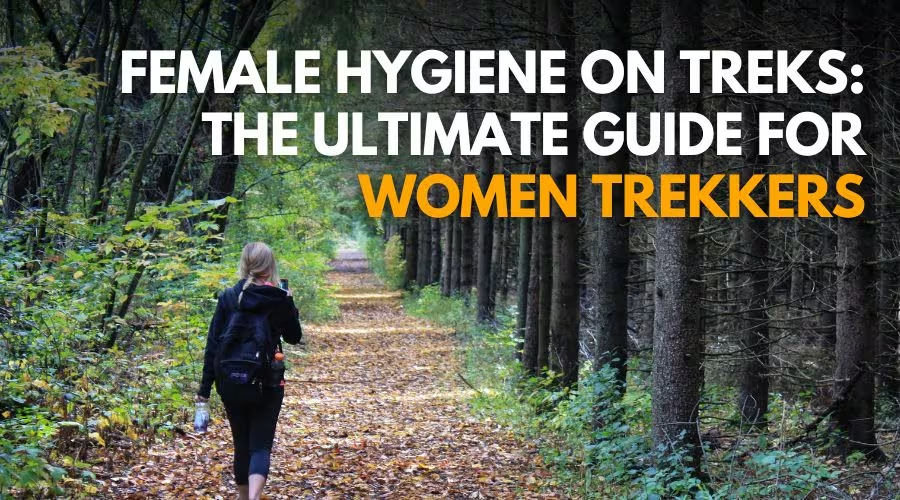The joy of trekking is unparalleled, but the thought of maintaining hygiene with limited access to toilets, is dreadful. You won’t be able to take a bath, have fancy toilets, but that doesn’t mean staying hygienic is impossible. The good news is that it is manageable with preparation and habits. Whether you’re on a short weekend hike or a multi-day high-altitude adventure trek, this blog will give you practical hygiene tips that keep you clean, healthy, and confident on the trail.
Poor hygiene on treks doesn’t just make you uncomfortable, but makes you prone to infections, irritation, chafing and more. Here’s how you can manage it smartly.
Table of Contents
Pre-Trek Preparation for Female Hygiene
1. Pack a Hygiene Kit:
Pack a hit that is easy to carry and stays accessible throughout your trek. These are some essential items you need to pack.
- Menstrual Products – Menstrual cups, pads, or tampons, choose the product that you are comfortable in.
- Un-scented wipes to clean yourself.
- Hand Sanitiser
- Ziplock Bags for store used products until proper disposal
- A quick dry towel
- Toilet paper or tissues, or a soft handkerchief
- Pee funnel
- Anti-chafing powder
- Face wipes
2. Clothing
Avoid clothing that traps sweat and moisture making it a welcome ground for bacteria. Instead choose moisture absorbing clothing and underwear, quick-dry hiking pants and leggings, sports bra with mesh panels or removable pads, and comfortable innerwear to avoid friction.
3. Menstrual Cycle
It is important to track your period cycle, and be prepared if the trek falls during you cycle, or if it pays you a visit unexpectedly on the trek. Here is a detailed article with tips to manage your periods during treks.
Maintaining Hygiene during the trek

1. Menstrual Hygiene:
- Menstrual cups: Empty every 8–12 hours into a cathole dug atleast 100 meters from water sources. Rinse with clean water or wipe with biodegradable soap before reinsertion. Sterilize cups in boiled water during resupply stops.
- Tampons and pads: Change every 4–6 hours. Store used items in odour-proof bags lined with baking soda to neutralize smells. Never bury disposable products, as they take years to decompose.
- Always carry extra underwear and panty liners.
- Read more which Menstrual Product To Choose For Treks
2. UTI and Yeast Infection Prevention
- Hydration: Drink 3–4 liters daily to flush out bacteria from the urinary tract.
- Urination habits: Never hold urine, use a pee funnel for ease of use or go the traditional way – whatever brings you relief. Wipe front-to-back with unscented wipes to prevent infection.
- Clothing changes: Swap damp underwear every night at the camp.
3. Peeing in the Wild:
Nature and treks do not come with a built-in toilet like your house. Here’s how to manage peeing and pooping in the mountains at high-altitudes.
- Choose a private, downhill spot, at least 100 ft away from water sources.
- If squatting is hard or you want to avoid mess, use a pee funnel.
- After peeing, wipe with toilet paper or a reusable cloth, and dry yourself to prevent infections.
- Pack out used TP in a ziplock, or use natural materials (leaves, smooth stones) if trained and safe.
- For quick drying: carry a small microfiber cloth labeled for this use and dry it under your backpack while hiking.
4. Pooping in the Wild
While trekking in a group with responsible trek organisations, they arrange makeshift toilets at the campsites. Even if you are solo, here’s how to manage it.
- Dig a cathole 6–8 inches deep and 200 ft away from trails/water.
- Use a small spade and cover the hole after.
- Wipe with biodegradable toilet paper and carry it in the ziplock bags.
- Use sanitizer every time after bathroom breaks.
5. Managing Sweat and Body Odor
Trekking is a physical activity, and you’ll sweat. It brings with it bacterial infections, and for women it can mean intimate sensitive areas.
- Use biodegradable wet wipes or cloth to wipe sweat-prone areas twice a day (underarms, groin, under breasts).
- Sprinkle antifungal powder or talcum in your underwear and bra lines to stay dry.
- Change your undergarments every day.
- Use a natural deodorant balm or wipes for underarms.
6. Facial and Dental Hygiene
- Use face wipes or just water, to clean your face.
- Avoid heavy skincare products. Best to use a moisturizer and a SPF sunscreen during the day.
- Carry a toothbrush and a mini toothpaste. If water is limited, brush with a mouth rinse or chew gum temporarily.
- Never spit near water sources. By now you must have understood; walk 200 metres away.
7. Keep Your Intimate Area Clean
We all know, this is one of the most crucial areas for female hygiene as it prone to infections.
In the wild, you are not going to be able to bath everyday, so here’s how you make sure to keep yourself clean.
- Wash once a day if available, or use unscented wipes.
- Avoid scented soaps, deodorants, or douches, they disrupt your pH balance.
- Wear breathable underwear, change daily, once you hit your camp.
- If prone to infections, carry a prescription antifungal cream or powder just in case.
8. Preventing and Managing Chafing
Long walks and sweat can cause painful chafing between the thighs, under your bra, or even armpits.
- Apply anti-chafing balm or Vaseline before hiking.
- Wear seamless, snug-fitting comfortable innerwear.
- Rinse/wipe and dry affected areas at night.
9. Nail and Foot Hygiene
You’ll be on your feet all day, make sure to take care of them.
- Trim nails before the trek to prevent dirt buildup and breakage.
- Carry a nail clipper in case of emergencies.
- Air out your feet at camp.
- Apply moisturizer or coconut oil to prevent cracked heels.
- Pack extra socks, and rotate them to avoid fungus and odor.
10. General Tips
- Use sanitizer after bathroom breaks and before meals. For thorough cleaning, apply biodegradable soap with water, scrubbing for atleast 30 seconds.
- Contrary to myths, menstruation does not attract bears or other wildlife.
- Hang your used wipes or clothes on the outside of your tent or backpack to dry overnight.
- Don’t use scented wipes in intimate areas.
- Do not dispose of any waste on the mountains. Seal off period waste, used products, wet wipes in ziplock bags and bring it back with you to dispose safely.
While the lack of facilities may seem overwhelming and unsettling at first, don’t demand for better facilities – trekking is to experience the wilderness, not to drive comfort. Once you get the hang of your personal hygiene system, it becomes easier to manage. Please adapt, respect the environment, and you will have a rewarding experience.

Leave a Comment